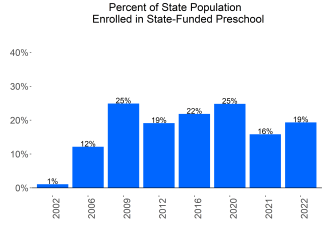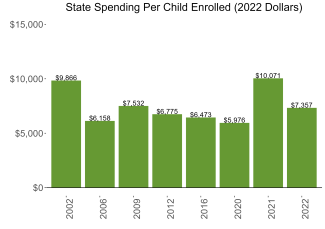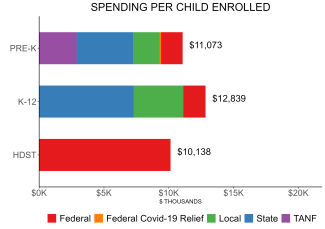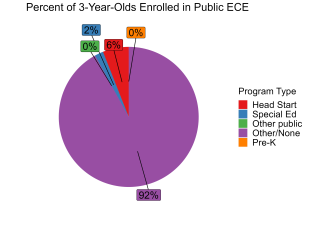
State of Preschool
North Carolina
Access Rankings
Resource Rankings
Total Benchmarks Met


Overview
During the 2021-2022 school year, North Carolina preschool enrolled 23,679 children, an increase of 3,742 from the prior year, as the program began to recover from the impact of the COVID-19 pandemic. State spending totaled $103,350,936 and an additional $68,300,000 in TANF funds and $2,549,993 in federal recovery funds supported the program, down $26,578,760 (13%), adjusted for inflation since last year. State spending per child equaled $7,357 in 2021-2022, down $2,714 from 2020-2021, adjusted for inflation. North Carolina met 8 of 10 quality standards benchmarks.
What's New
During the 2021 Long Session, the NC General Assembly (GA) passed a biennium budget that provided a 4% recurring rate increase for private North Carolina Pre-Kindergarten (NC Pre-K) classrooms, which is intended to raise teacher salaries. This went into effect as a 2% increase in the 2021-2022 school year and an additional 2% increase for 2022-2023 school year. In the Short Session of 2022, the NC GA instituted a 5% overall rate increase for all NC Pre-K sites.
Due to the recent shifts in the economy, many families in North Carolina have income that is above the 75% SMI as required in the NC Pre-K Program Income Eligibility Requirements. Prior to the beginning of the 2022-2023 program year, enrollment patterns showed a sharp decline in enrollment in several of the largest urban counties, and an increase in the more rural counties. The NC Pre-K programs in the rural counties have expressed interest in serving more children. The Division of Child Development and Early Education provided classroom-based payments in order to provide stabilization to NC Pre-K programs during the COVID-19 pandemic. This meant that NC Pre-K classroom reimbursement rates were not contingent on child enrollment or attendance for the entire 2021-2022 program year.
Background
North Carolina has provided state-funded pre-kindergarten education since 2001, originally via the More at Four Pre-Kindergarten Program. During the 2011-2012 school year, the program was renamed the North Carolina Pre-Kindergarten (NC Pre-K) Program, and administrative control moved from the Department of Public Instruction to the Department of Health and Human Services. NC Pre-K enrolls at-risk 4-year-olds from low-income families who have not participated in other early childhood programs. NC Pre-K programs are required to operate 6.5 hours per day for 36 weeks each year and serve as many eligible children as funding levels permit. Eligibility generally requires children to be in a household with income at or below 75% SMI, but up to 20% of children may be in a household with a higher income if they have another designated risk factor. Risk factors include a developmental delay or identified disability, a chronic health condition, or limited English proficiency.
Funding for NC Pre-K includes state general appropriations and North Carolina Education Lottery receipts, federal funds, and a local contribution, with the majority of the funding from the state. NC Pre-K classrooms operate statewide in settings such as privately licensed Head Start programs, childcare centers, and public schools. All programs, whether in public or private settings, must earn high-quality ratings under the state child-care licensing system to participate in NC Pre-K and the state’s subsidy system. NC Pre-K sets a maximum class size of 18 4-year-olds and requires a staff-child ratio of 1:9. Lead teachers must have a bachelor’s degree and hold or be working towards a birth-through-kindergarten license. Classroom staff are required to use approved curricula and formative assessments aligned with the state’s early learning standards. Staff conduct ongoing formative assessments to gather information about each child’s growth and skill development, as well as to inform instruction.
North Carolina Pre-Kindergarten Program
Access
Resources
| Total state pre-K spending | $174,200,929 |
| Local match required? | Yes |
| State Head Start spending | $0 |
| State spending per child enrolled | $7,357 |
| All reported spending per child enrolled* | $11,073 |

Pre-K programs may receive additional funds from federal or local sources that are not included in this figure. K–12 expenditures include capital spending as well as current operating expenditures. Head Start per-child spending includes funding only for 3- and 4-year-olds.
NC Quality Standards Checklist
| Policy | Requirement | Benchmark | Meets Benchmark? |
|---|---|---|---|
For more information about the benchmarks, see the Executive Summary and the Roadmap to State pages. | 8benchmarks met | ||
| Early Learning & Development Standards Benchmark | Comprehensive, aligned, supported, culturally sensitive | Comprehensive, aligned, supported, culturally sensitive | |
| Curriculum Supports Benchmark | Approval process & supports | Approval process & supports | |
| Teacher Degree Benchmark | BA | BA | |
| Teacher Specialized Training Benchmark | ECE, CD | Specializing in pre-K | |
| Assistant Teacher Degree Benchmark | HSD | CDA or equivalent | |
| Staff Professional Development Benchmark | 6 semester hours/year (teachers), 5 clock hours/year (assistants); PD plans; Coaching | For teachers & assistants: At least 15 hours/year; individual PD plans; coaching | |
| Maximum Class Size Benchmark | 18 (4-year-olds) | 20 or lower | |
| Staff to Child Ratio Benchmark | 1:9 (4-year-olds) | 1:10 or better | |
| Screening & Referral Benchmark | Vision, hearing, health & more | Vision, hearing & health screenings; & referral | |
| Continuous Quality Improvement System Benchmark | Structured classroom observations; Data used for program improvement | Structured classroom observations; data used for program improvement | |

